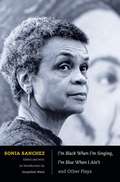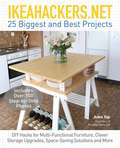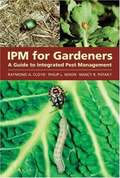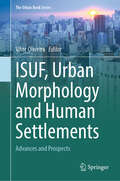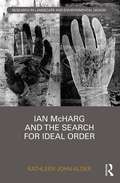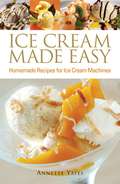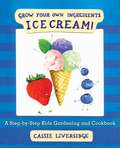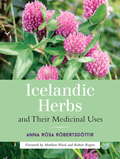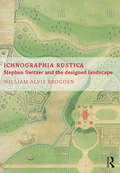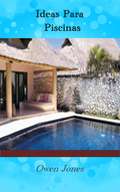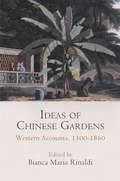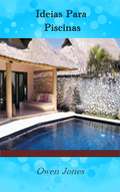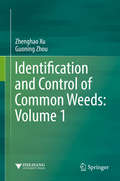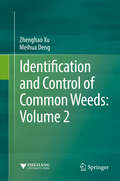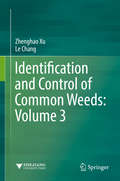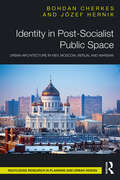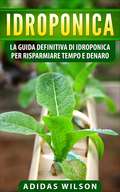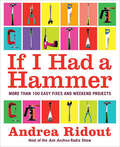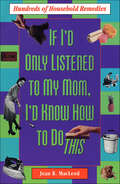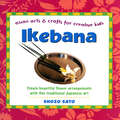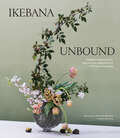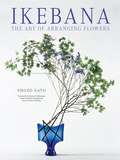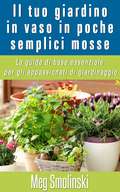- Table View
- List View
I'm Black When I'm Singing, I'm Blue When I Ain't: And Other Plays
by Sonia SanchezSonia Sanchez is a prolific, award-winning poet and one of the most prominent writers in the Black Arts movement. This collection brings her plays together in one volume for the first time. Like her poetry, Sanchez's plays voice her critique of the racism and sexism that she encountered as a young female writer in the black militant community in the late 1960s and early 1970s, her ongoing concern with the well-being of the black community, and her commitment to social justice. In addition to The Bronx Is Next (1968), Sister Son/ji (1969), Dirty Hearts (1971), Malcolm/Man Don't Live Here No Mo (1972), and Uh, Uh; But How Do It Free Us? (1974), this collection includes the never-before-published dramas I'm Black When I'm Singing, I'm Blue When I Ain't (1982) and 2 X 2 (2009), as well as three essays in which Sanchez reflects on her art and activism. Jacqueline Wood's introduction illuminates Sanchez's stagecraft in relation to her poetry and advocacy for social change, and the feminist dramatic voice in black revolutionary art.
IKEAHACKERS.NET 25 Biggest and Best Projects: DIY Hacks for Multi-Functional Furniture, Clever Storage Upgrades, Space-Saving Solutions and More
by Jules YapThe ingenious team at IkeaHackers.net show you how to transform affordable IKEA products into creative new furniture and more!Jules Yap and the contributors to her wildly popular website IkeaHackers.net show you how to transform affordable IKEA® products into creative new furniture and more. With clear instructions and easy-to-follow photos, you&’re sure to have fun building these exciting hacks, including: • Kitchen Island• Dollhouse• Vanity• Built-In Home Office• Mudroom Bench
IPM for Gardeners: A Guide to Integrated Pest Management
by Raymond A. Cloyd Philip L. Nixon Nancy R. PatakyMany nurseries, land-use agencies, and public gardens now require the use of IPM as an intelligent, real-world system to raise plants in an environmentally responsible manner.
ISUF, Urban Morphology and Human Settlements: Advances and Prospects (The Urban Book Series)
by Vítor OliveiraThis book offers insight into the most important scientific society on urban morphology worldwide: the International Seminar on Urban Form (ISUF). After addressing the three-decade history of ISUF, the book analyses the present and future of this scientific society, of urban morphology, and of human settlements. This timely and fundamental reflection gathers contributions from present and past leadership of ISUF since its inception in 1994. Over the last three decades, the urban world has undergone major changes: the urban population is now higher than the rural population; more than half of the world's population lives on a single continent—Asia, home to almost three billion people in China and India alone—so geographical imbalance is considerable; and while half of the urban population still lives in small cities of fewer than 300,000 inhabitants, the number of megacities has increased significantly. How does the physical form of cities in different parts of the world respond to these dynamics? Can cities preserve fundamental elements of humankind's urban heritage while accommodating changes driven by the main socioeconomic and environmental needs of today? The field of urban morphology has been continuously adjusting to the essential dynamics of its object of study. While developing and strengthening its most robust theories, concepts, and methods designed after the mid-twentieth century, urban morphology has been able to integrate innovative approaches for describing and explaining the emerging dynamics and patterns of urban form—often incorporating groundbreaking technologies for data collection, analysis, modelling, and simulation. But what is the role of urban morphology in science and society today? How effective is it in communicating a rigorous understanding of the urban landscape both to academics and researchers in other fields and to citizens in general? How successful is it in providing practitioners with relevant and useful knowledge that informs their action on cities' form and structure through spatial planning, urban design, and architecture? This book addresses these fundamental questions, offering academics, researchers, and practitioners comprehensive knowledge on human settlements, the field of urban morphology, and the role of ISUF in promoting groundbreaking morphological thought.
Ian McHarg and the Search for Ideal Order (Routledge Research in Landscape and Environmental Design)
by Kathleen John-AlderIan McHarg and the Search for Ideal Order looks at the well-known and studied landscape architect, Ian McHarg, in a new light. The author explores McHarg’s formative years, and investigates how his ideas developed in both their complexity and scale. As a precursor to McHarg’s approach in his influential book Design with Nature, this book offers new interpretations into his search for environmental order and outlines how his struggle to understand humanity’s relationship to the environment in an era of rapid social and technological change reflects an ongoing challenge that landscape design has yet to fully resolve. This book will be of great interest to academics and researchers in landscape architectural history.
Ice Cream Made Easy: Homemade Recipes for Ice Cream Machines
by Annette YatesIce Cream Made Easy shows how to make luscious, creamy concoctions, light-and-airy yogurt mixtures and dairy-free ice creams, as well as refreshing fruit-filled sorbets, icy granitas and slushy drinks. And if that's not enough, there's a selection of dreamy toppings and sauces, plus some inspirational ideas for quick ice cream desserts.There are ices to suit any occasion (simple or stylish) at any time of the year from classic favourites like Vanilla or Chocolate to modern flavours like Strawberry Pavlova Ripple, Toasted Apple and Cinnamon, or Chunky Pecan and Maple.Don't worry if you haven't got an ice cream machine, as many of the recipes can be made by hand. Most are so easy to make and so scrumptious that you may not want to share them - you may want to indulge all by yourself!
Ice Cream!: Grow Your Own Ingredients
by Cassie LiversidgeIce cream is the most popular dessert across the globe, and now kids can learn how to make their very own ice cream with this step-by-step guide. Master gardener Cassie Liversidge's cutout art accompanies simple, easy-to-understand instructions for planting and growing mint, strawberries, and blueberries-all important ingredients you need for different ice cream flavors. Even kids who have never met a weed can tackle this project! Parents will appreciate reminders to wait patiently and handle buds and flowers gently; kids will love the jokes scattered throughout the book. (What did one strawberry say to the other strawberry? Look at the jam you've gotten us into!) Budding chefs will love following this easy guide and will take pride in each step of the culinary process, from planting strawberry seeds to serving a delicious dessert!Ice Cream! is part gardening book and part cookbook and is sure to delight young gardeners and cooks. This is the perfect springtime gift for food-loving children. And as a bonus, watching strawberries and blueberries grow from seeds and learning how to cook is the perfect way to get kids to appreciate their fruit!
Icelandic Herbs and Their Medicinal Uses
by Matthew Wood Robert Rogers Anna Rosa RobertsdottirThis beautifully illustrated, full-color guide provides everything readers need to know about the medicinal powers of 90 native herbs of Iceland--85 of which also grow in North America. Anna Rosa Robertsdottir describes the history, uses, harvesting, drying, and storage of the plants, and includes a wealth of detailed instructions for their preparation--including infusions, decoctions, tinctures, and syrups. Generous color photographs of both the leaves and flowers facilitate plant identification, allowing both amateur and professional herbalists to use the guide to full advantage. User-friendly layout, meticulous research, a wealth of detailed information, and an extensive bibliography make this an essential, one-of-a-kind reference for anyone interested in the subject. For each herb, sidebars describe: Habitat Parts used Harvesting Constituents History Action Uses Research DosageFrom the Trade Paperback edition.
Ichnographia Rustica: Stephen Switzer and the designed landscape
by William Alvis BrogdenOne of the most significant occurrences in the history of design was the creation of the English Landscape Garden. Accounts of its genesis…the surprising structural change from the formal to a seeming informal are numerous. But none has ever been quite convincing and none satisfactorily placed the contributions of Stephen Switzer. Unlike his contemporaries, Switzer - an 18th century author of books on gardening and agricultural improvement - grasped a quite new principle: that the fashionable pursuit of great gardens should be "rural and extensive", rather than merely the ornamentation of a particular part of an estate. Switzer saw that a whole estate could be enjoyed as an aesthetic experience, and by the process of improving its value, could increase wealth. By encouraging improvers to see the garden in his enlarged sense, he opened up the adjoining countryside, the landscape, and made the whole a subject of unified design. Some few followed his advice immediately, such as Bathurst at Cirencester. But it took some time for his ideas to become generally accepted. Could this vision, and its working out in practice between 1710 and 1740 be the very reason for such changes? 300 years after the first volume of his writings began to be published; this book offers a timely critical examination of lessons learned and Switzer’s roles. In major influential early works at Castle Howard and Blenheim, and later the more "minor" works such as Spy Park, Leeswood or Rhual, the relationships between these designs and his writings is demonstrated. In doing so, it makes possible major reassessment of the developments, and thus our attitudes to well-known works. It provides an explanation of how he, and his colleagues and contemporaries first made what he had called Ichnographia Rustica, or more familiarly Modern Gardening from the mid-1740s, land later landscape gardens. It reveals an exceptional innovator, who by transforming the philosophical way in which nature was viewed, integrated good design with good farming and horticultural practice for the first time. It raises the issue of the cleavage in thought of the later 18th century, essentially whether the ferme ornee as the mixture of utile and dulci was the perfect designed landscape, or whether this was the enlarged garden with features of "unadorned nature"? The book discusses these considerable and continuing contrary influences on later work, and suggests Switzer has many lessons for how contemporary landscape and garden design ought be perceived and practised.
Ideas Para Piscinas: Diecisiete capítulos sobre cómo crear, mantener y usar de forma segura una piscina de jardín.
by Owen JonesHola y gracias por comprar mi libro electrónico llamado ‘Ideas Para Piscinas'. Espero que encuentre aquí información útil, práctica y posiblemente rentable en el futuro. La información en este libro electrónico sobre cómo aprovechar al máximo las ideas que pueda tener sobre piscinas hogareñas está organizada en 17 capítulos de aproximadamente 500 a 600 palabras cada uno. Espero que les interese a quienes quieran comenzar a construir o aprovechar al máximo una piscina hogareña. También será útil para aquellos que podrían estar pensando en iniciarse en el negocio de construir o cuidar piscinas. Sin embargo, es una guía para principiantes, aunque con la esperanza de que sea lo suficientemente interesante como para comenzar. Como un bono adicional, le concedo permiso para usar el contenido en su propio sitio web o en sus propios blogs y boletines, aunque es mejor si los vuelve a escribir con sus propias palabras. También puede dividir el libro y revender los artículos. De hecho, el único derecho que no tiene es revender o regalar el libro tal como se le entregó.
Ideas of Chinese Gardens: Western Accounts, 1300-1860 (Penn Studies in Landscape Architecture)
by Bianca Maria RinaldiEuropeans may be said to have first encountered the Chinese garden in Marco Polo's narrative of his travels through the Mongol Empire and his years at the court of Kublai Khan. His account of a man-made lake abundant with fish, a verdant green hill lush with trees, raised walkways, and a plethora of beasts and birds took root in the European imagination as the description of a kind of Eden. Beginning in the sixteenth century, permanent interaction between Europe and China took form, and Jesuit missionaries and travelers recorded in letters and memoirs their admiration of Chinese gardens for their seeming naturalness. In the eighteenth century, European taste for chinoiserie reached its height, and informed observers of the Far East discovered that sophisticated and codified design principles lay behind the apparent simplicity of the Chinese garden. The widespread appreciation of the eighteenth century gave way to rejection in the nineteenth, a result of tensions over practical concerns such as trade imbalances and symbolized by the destruction of the imperial park of Yuanming yuan by a joint Anglo-French military expedition.In Ideas of Chinese Gardens, Bianca Maria Rinaldi has gathered an unparalleled collection of westerners' accounts, many freshly translated and all expertly annotated, as well as images that would have accompanied the texts as they circulated in Europe. Representing a great diversity of materials and literary genres, Rinaldi's book includes more than thirty-five sources that span centuries, countries, languages, occupational biases, and political aims. By providing unmediated firsthand accounts of the testimony of these travelers and expatriates, Rinaldi illustrates how the Chinese garden was progressively lifted out of the realm of fantasy into something that could be compared with, and have an impact on, European traditions.
Ideias Para Piscinas
by Owen JonesIdeias Para Piscinas Espero que você ache as informações prestativas, úteis e lucrativas. As informações contidas neste e-book sobre como aproveitar ao máximo todas as ideias que você possa ter sobre uma piscina doméstica estão organizadas em 17 capítulos com cerca de 500 a 600 palavras cada. Espero que seja do interesse dos que desejam fazer algo para criar ou aproveitar ao máximo uma piscina doméstica. Também será útil para aqueles que pensam em começar a criar ou cuidar de piscinas. No entanto, é um guia para iniciantes, embora seja esperançoso o suficiente para interessá-lo ou começar. Como um bónus adicional, concedo-lhe a permissão para usar o conteúdo no seu próprio site ou nos seus próprios blogs e newsletter, embora seja melhor se antes você os reescrever com as suas próprias palavras. Você também pode dividir o livro e revender os artigos. De facto, o único direito que você não tem é revender ou doar o livro conforme ele lhe foi entregue a si.
Identification and Control of Common Weeds: Volume 1
by Zhenghao Xu Guoning ZhouThis book introduces readers to nearly 600 common weeds. In addition to essential information, each chapter includes photos for a specific type of weed to show its morphology in different growth periods, such as seedling, root, flower, fruit, and mature plant. The book also discusses control measures, including agricultural, chemical, physical, biological, and comprehensive methods. The Volume1 mainly focuses on 126 species of grass weeds and 34 species of sedge weeds. With the development of society and economics, weeds have become a recurring problem. In particular, the exotic, invasive, and quarantine weeds have spread dramatically and rapidly. On the other hand, many people, even those who are engaged in weed control, do not (or cannot) distinguish between weeds. Thus there is significant demand for illustrations of weed morphologies, as well as information on their control measures. This book offers a valuable, practical guide for all those working in the fields of crop cultivation, plant protection and quarantine management.
Identification and Control of Common Weeds: Volume 2
by Zhenghao Xu Meihua DengThis book introduces readers to nearly 600 common weeds. In addition to essential information, each chapter includes photos for a specific type of weed to show its morphology in different growth periods, such as seedling, root, flower, fruit, and mature plant. The book also discusses control measures, including agricultural, chemical, physical, biological, and comprehensive methods. The Volume2 mainly focuses on fern and 216 species of weeds of magnoliids or dicotyledoneae. With the development of society and economics, weeds have become a recurring problem. In particular, the exotic, invasive, and quarantine weeds have spread dramatically and rapidly. On the other hand, many people, even those who are engaged in weed control, do not (or cannot) distinguish between weeds. Thus there is significant demand for illustrations of weed morphologies, as well as information on their control measures. This book offers a valuable, practical guide for all those working in the fields of crop cultivation, plant protection and quarantine management.
Identification and Control of Common Weeds: Volume 3
by Zhenghao Xu Le ChangThis book introduces readers to nearly 600 common weeds. In addition to essential information, each chapter includes photos for a specific type of weed to show its morphology in different growth periods, such as seedling, root, flower, fruit, and mature plant. The book also discusses control measures, including agricultural, chemical, physical, biological, and comprehensive methods. The Volume 3 mainly focuses on 252 Species of Dicotyledonous and Monocotyledonous Weeds along with 2 Species of Liverworts and Mosses. With the development of society and economics, weeds have become a recurring problem. In particular, the exotic, invasive, and quarantine weeds have spread dramatically and rapidly. On the other hand, many people, even those who are engaged in weed control, do not (or cannot) distinguish between weeds. Thus there is significant demand for illustrations of weed morphologies, as well as information on their control measures. This book offers a valuable, practical guide for all those working in the fields of crop cultivation, plant protection and quarantine management.
Identity in Post-Socialist Public Space: Urban Architecture in Kiev, Moscow, Berlin, and Warsaw
by Józef Hernik Bohdan CherkesThis book is a comparative analysis of the architecture of central public spaces of capital cities in Central and Eastern Europe during the period of their authoritarian and post-authoritarian development. It demonstrates that national identity transformations cause structural changes in urban public spaces, and theorises identity and national identity within urban planning in order to explain the influence of historical, cultural, mental, social as well as ideological and political conditions on the processes of shaping and perceiving the architecture of public space. The book addresses the process of shaping and restructuring historic centres of European capital cities of Kiev, Moscow, Berlin, and Warsaw, which developed under authoritarian regime conditions throughout the 20th century and were characterised by ideological determinism and the influence of state ideology and politics on the architecture of public spaces. The book will be useful for urban planners, architects, land management specialists, art historians, political scientists, and readers interested in the theory and history of cities, the fundamentals of urban planning and architecture, and the planning of cities and public spaces.
Identity in Post-Socialist Public Space: Urban Architecture in Kiev, Moscow, Berlin, and Warsaw (Routledge Research in Planning and Urban Design)
by Józef Hernik Bohdan CherkesThis book is a comparative analysis of the architecture of central public spaces of capital cities in Central and Eastern Europe during the period of their authoritarian and post-authoritarian development. It demonstrates that national identity transformations cause structural changes in urban public spaces, and theorises identity and national identity within urban planning in order to explain the influence of historical, cultural, mental, social as well as ideological and political conditions on the processes of shaping and perceiving the architecture of public space. The book addresses the process of shaping and restructuring historic centres of European capital cities of Kiev, Moscow, Berlin, and Warsaw, which developed under authoritarian regime conditions throughout the 20th century and were characterised by ideological determinism and the influence of state ideology and politics on the architecture of public spaces. The book will be useful for urban planners, architects, land management specialists, art historians, political scientists, and readers interested in the theory and history of cities, the fundamentals of urban planning and architecture, and the planning of cities and public spaces.
Idroponica: la guida definitiva di idroponica per risparmiare tempo e denaro
by Adidas WilsonLa parola idroponica ha origine dal latino che significa semplicemente “acqua di lavoro”. In parole povere, l'idroponica è l'arte di coltivare colture senza usare il suolo. Quando pensiamo subito all'arte dell'idroponica, immaginiamo piante che crescono con le radici sospese nell'acqua senza avere alcun mezzo. Beh, questo è vero, in quanto è una forma di giardinaggio idroponico che è stata definita tecnica del film nutritivo o NFT. Proprio come qualsiasi cosa che si inizia, il primo obiettivo da raggiungere è avere un piano. Dovrai considerare lo spazio che hai a disposizione per il giardinaggio. Se stai pianificando di coltivare il tuo giardinaggio al chiuso in uno spazio ristretto, assicurati che ci sia spazio sufficiente per eseguire la manutenzione ordinaria.
Idée d'aménagement de piscine: Comment amenager et sécuriser votre piscine
by Owen JonesDescription du livre: J'espère que vous trouverez les informations utiles, utiles et profitables. Les informations contenues dans ce livre électronique sur la façon de tirer le meilleur parti de toutes les idées que vous pouvez avoir au sujet d'une piscine domestique sont organisées en 17 chapitres d'environ 500 à 600 mots chacun. J'espère qu'elles intéresseront ceux qui souhaitent créer une piscine domestique ou en tirer le meilleur parti. Il sera également utile à ceux qui envisagent de se lancer dans la création ou l'entretien de piscines. Il s'agit toutefois d'un guide pour débutants, mais j'espère qu'il suffira à vous intéresser ou à vous lancer. En prime, je vous autorise à utiliser le contenu de ce guide sur votre propre site web ou dans vos blogs et bulletins d'information, mais il est préférable que vous le réécriviez d'abord avec vos propres mots. Vous pouvez également diviser le livre et revendre les articles. En fait, le seul droit que vous n'avez pas est de revendre ou de donner le livre tel qu'il vous a été livré.
If I Had a Hammer: More Than 100 Easy Fixes and Weekend Projects
by Andrea RidoutHave fun, save money, and improve your home with these easy step-by-step projectsAre you looking for a way to make your bathroom a little more beautiful? Or maybe you'd like to give your tired furniture a face-lift, improve your home's air quality, or fix a toilet. No matter your DIY needs and no matter whether you're a DIY novice or expert, home improvement guru Andrea Ridout, host of the nationally syndicated radio show Ask Andrea, has ideas, expertise, and advice to share with you. If I Had a Hammer offers easy-to-follow instructions and illustrations designed to make home improvement simpler than ever. With a little help from Andrea, you'll be able to tackle repairs, painting and decorating, bathroom and kitchen remodeling, wood care for furniture and floors, and much more with projects that often take as little as an hour. Also, you can try a few of Andrea's energy-conserving projects that can dramatically improve your utility bill—Andrea's projects are friendly on the environment and on your wallet! With If I Had a Hammer, you'll have the tools to keep your home functioning and looking as good as—or even better than—new.
If I'd Only Listened to My Mom, I'd Know How to Do This: Hundreds of Household Remedies
by Jean B. MacLeodA collector of practical information, Jean MacLeod had useful tips scattered around her home: in the back of recipe files, in her personal notes, in the front of books. Finally she decided she had to find a better system to organize this goldmine of information, so she arranged the tips into book form: If I'd Only Listened to Mom. This encyclopedic yet accessible volume is the result. Arranged alphabetically by topic in an easy-to-find, easy-to-read format, it offers a potpourri of options--countless simple yet effective solutions to everyday household problems that can save you time as well as money. Hints such as:To clean car windows rub them with cola which removes grease and filmTo silence a dripping faucet, tie a piece of string to the faucet until you can fix it. The water will roll down the string, eliminating the dripping noise.To prolong the life of batteries, scrape both ends with sandpaper, a nail file or an emery boardTo remove stains from carpet, spray foamy shaving cream on the stain, allow to sit for a few seconds, then rinse with a damp sponge.And many, many more.
Ikebana
by Shozo SatoUsing colorful illustrations this multicultural children's book introduces readers to Japanese Ikebana.Ikebana, the ancient Japanese art of flower arranging, has never been easier--or more fun! <P><P>This colorful, easy-to-follow guide will walk you through the steps of 10 different ikebana projects. Before you know it you'll be creating your very own unique and beautiful flower arrangements. Creating flower arrangements is a great way to explore this time-honored Japanese art form. <P>Following the step-by-step instructions, you'll learn to arrange how to create: <br>Kenzan Moribana--a basic style using a low, open container <br>Nageire Ikebana--formal arrangements that balance length and weight <br>Suiban (Water Platter) Ikebana--the earliest form of Ikebana, using a shallow platter filled with water <br>Natural Style Ikebana--arrangements that imitate nature <P>Once you've created your own arrangements, you can display them or give them as gifts, sharing a part of nature--and your creativity--with the people around you.About the Series:The Asian Arts & Crafts for Creative Kids series is the first series, aimed at readers ages 7-12, that provides a fun and educational introduction to Asian culture and art. Through hands on projects readers will explore each art--engaging in activities to gain a better understanding of each form.
Ikebana Unbound: A Modern Approach to the Ancient Japanese Art of Flower Arranging
by Amanda Luu Ivanka Matsuba"A modern take on a centuries-old art that’s breathtakingly simple.&”—Booklist, starred review At its heart, the Japanese art of ikebana is about celebrating an intimate connection with nature. To practice ikebana is to find inspiration in the seasons, favor unassuming blooms and branches, seek balance and simplicity, and remain fully present in the moment. It is a beautiful, pure antidote to our age of distraction and excess. Honoring the lineage of ikebana while making the art their own, Amanda Luu and Ivanka Matsuba of Studio Mondine show us new ways to tell stories with flowers. They offer step-by-step instructions for dozens of stunning, seasonal arrangements, while in the process introducing readers to the themes and stylistic signatures of the art. In Studio Mondine’s hands, this centuries-old practice feels undeniably fresh—and readers are given the gift of learning to create unique, meaningful, and authentic arrangements.
Ikebana: The Art of Arranging Flowers
by Shozo Sato Kasen YoshimuraIkebana, the Japanese art of flower arranging, is more than simply putting flowers in a container. It is a disciplined art form in which the arrangement is a living thing where nature and humanity are brought together.Ikebana: The Art of Arranging Flowers, a classic Ikebana text, has now been completely updated for modern readers. Written by Shozo Sato, a well-respected and renowned Ikebana expert, this book presents a fascinating overview of the history of Ikebana to present day, and introduces classic Ikebana styles such as Rikka, Seika and Moribana to Freestyle. The reader is familiarized with the tools of Ikebana and the basic Ikebana flower-arranging techniques. Simple and detailed instructions guide Ikebana enthusiasts through the process of making dozens of stunning arrangements.
Il tuo giardino in vaso in poche semplici mosse
by Meg Smolinski Vanessa P.Il giardinaggio in vaso è divertente, facile ed è un ottimo modo per far crescere dei prodotti freschi quasi tutto l’anno. Questa guida aiuterà sia i principianti sia gli esperti giardinieri ad ottenere il massimo dal tuo giardino in vaso con fantastici trucchi e consigli! In questo libro imparerai: 1. A comprendere il concetto di giardinaggio in vaso e come questo sia il modo migliore per le persone in tutto il mondo per iniziare a fare del giardinaggio – anche per coloro che vivono in appartamento in un condominio! 2. A scegliere il giusto tipo di contenitori per il tuo giardino in vaso 3. Dei consigli per evitare che le tue piante muoiano! 4. La manutenzione adatta a un giardino urbano 5. I segreti su come mantenere bello e prosperoso il tuo giardino in vaso Inizia oggi a lavorare al tuo giardino in vaso e fai crescere dei bei fiori, ortaggi e della bella frutta. Acquista questa guida per creare il tuo giardino in modo CORRETTO
